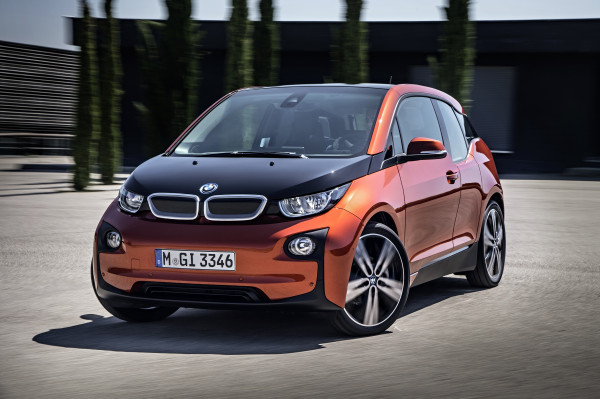All of that activity in Europe you’ve been seeing of late, whether it involves Tesla Motors or aggressive electric vehicle development plans in the United Kingdom, heralds this part of the world is moving more towards embracing more zero emissions driving. This is highlighted in a new report recently released by IHS Automotive which suggests that, driven by tighter emissions standards in Europe, worldwide production of electric vehicles will rise by over two-thirds this year alone.
As a result of this, IHS predicted, total production of electric cars, including plug-in hybrids, will rise to over 400,000 in 2014, which is a roughly 60,000 unit increase from 2013. The Europe, Middle East and Africa region will account for the largest share of production at more than 40 percent, with the Americas and Asia-Pacific each making up about 30 percent.

Besides forecasting this growth in these types of vehicles, the report had a range of other interesting predictions for the year concerning EVs, which I share with you below:
- This year will offer more choices for consumers who are considering buying EVs. Battery electric vehicles from the German carmakers including the BMW i3, Volkswagen’s e-Up!, the Mercedes-Benz B-Class Electric and Audi’s A3 e-tron plug-in hybrid are welcome additions to the current lineup of electric propulsion vehicles in 2014. More product availability and greater choice will help widespread adoption of EVs.
- The global installed base of EV charging stations is set to reach more than 1.1 million units worldwide by the end of this year.
- This year will see the worldwide rollout of public “trio” chargers that comply with the AC-Type 2 Mode 3, DC-CHAdeMO and DC-CCS standards. These public infrastructure solutions have complete compatibility with all EV models, although coming at a price for charge-station owners. Trio chargers are large, imposing metal boxes containing power electronics and three connector types. And while trio chargers offer more flexibility in terms of charging, they reflect uncertainty in the future direction of charging standards. The domestic charging market, typically an AC domain, will be shaken up this year with the introduction of DC chargers. Although the product is more expensive than a domestic AC charger, suppliers are confident that the cost of a domestic DC charger can be brought down over time, with installations likely in Europe and China.
- Business conditions in 2014 will be tough for companies that manufacture AC charging stations. Pricing for domestic AC charging stations is decreasing and starting to reach commodity levels. Margins are low and are expected to become smaller, resulting in an unviable business case.
- In 2014 and the coming years, automakers will deliver concept and production EVs with large batteries that have capacities of approximately 40 kilowatt hours (kWh), which equates to at least a 150-mile range. Lithium-ion battery prices are decreasing as a result of the price war between LG Chem, the battery supplier to the Chevrolet Volt; and Panasonic, the battery supplier for Tesla’s Model S. Because of this, carmakers can afford to put larger batteries into their vehicles and reduce range anxiety.
- Suppliers and original equipment manufacturers (OEM) are expected to demonstrate more energy-and fuel-saving technologies this year. Ford has presented its C-MAX Solar Energi Concept, which uses a solar panel on the roof of the car. With the help of a solar concentrator, enough energy can be drawn from the sun in a day to equal a four-hour battery charge equal to 8 kWh. Bosch has developed a new start/stop system that shuts off the engine when the car is coasting, delivering fuel savings of up to 10 percent. Technologies like this could bring internal combustion engine (ICE) vehicles closer to the energy-saving benefits of hybrid electric vehicles.
- Public charging-station operators and owners will continue to struggle to make a profit on electric vehicle charging in 2014. Although electric vehicle production is slowly increasing and is closer to reaching the expectations of five years ago, there aren’t enough grid-dependent vehicles on the road yet to generate large revenues from public charging. Other forms of revenue generation will need to be implemented this year by operators and owners, such as advertisements on charging stations using integrated liquid-crystal display screens.
- This year will be important for new energy vehicles (NEVs)—i.e., EVs, PHEVs and fuel cell cars—in China with deployment of these vehicles driven by government policy. In Beijing, for example, the city aims to limit new-vehicle sales to curb pollution while simultaneously increasing deployment of NEVs. The city plans to deploy a total of 170,000 NEVs from 2014 and 2017, with 20,000 NEVs introduced in 2014.
- The price of EVs is expected to decrease in 2014, as more OEMs enter the market place. Although Nissan recently announced a slight price increase on the 2014 Leaf from last year, there is a decrease of about $6,000 between the 2012 and 2014 models. The price of the 2014 Chevrolet Volt also experienced a similar price drop, and other vehicle models will likely follow the trend. Price is the main reason why uptake of these vehicles hasn’t been as high as expected, so incentives are critical if countries are serious about the adoption of such vehicles. In 2014 it may be possible that we see EV legislation or incentives in new regions.